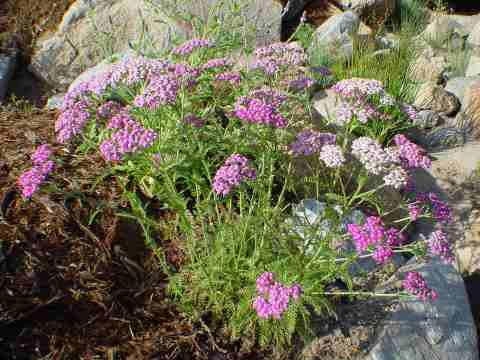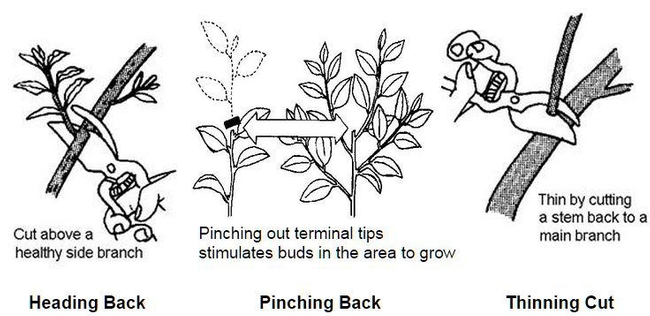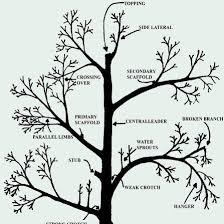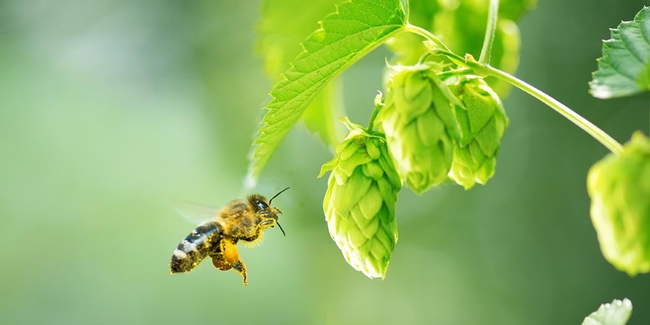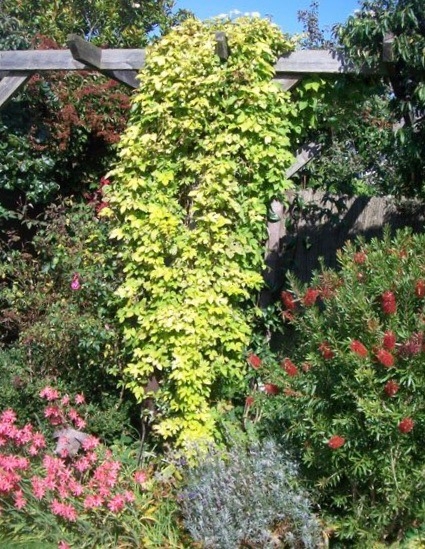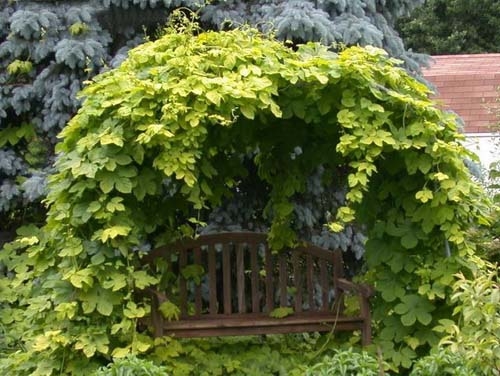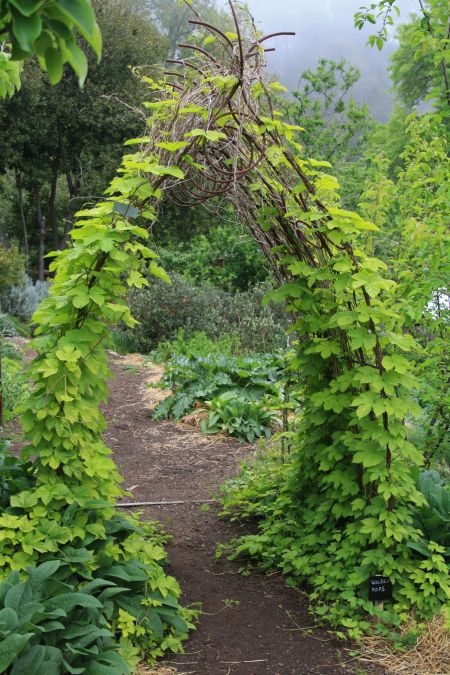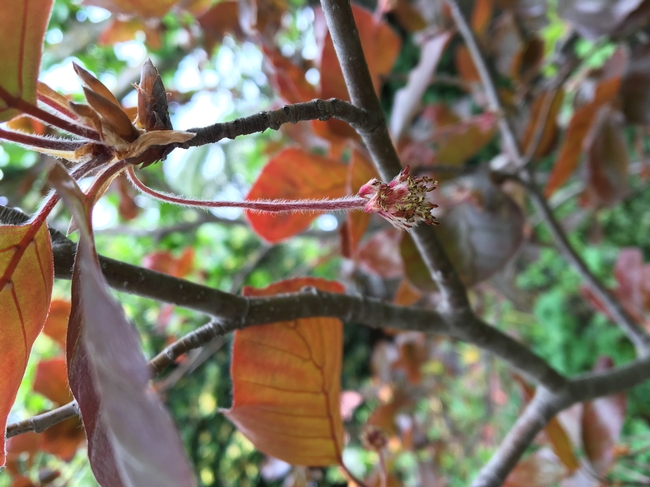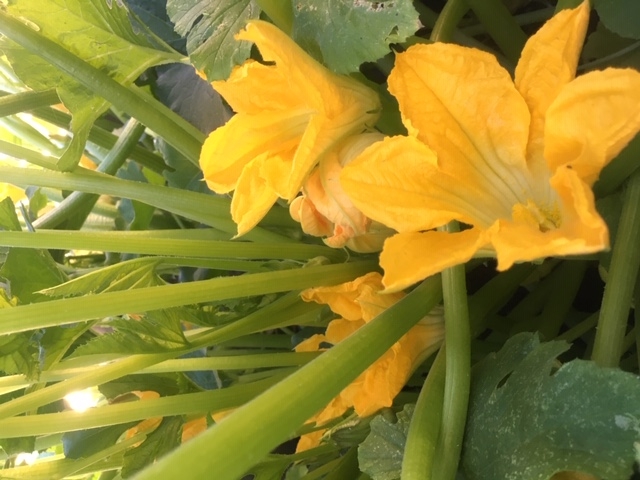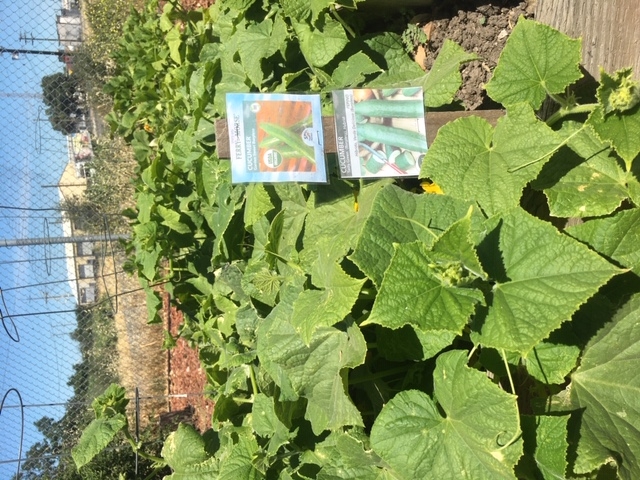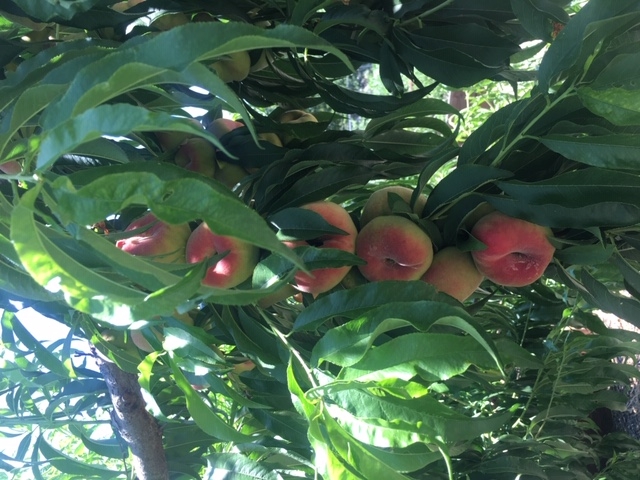- Author: Melissa Berg, Master Gardener
Our Master Gardener Demonstration Garden is located at the San Joaquin County Agricultural Center located at 2102 E. 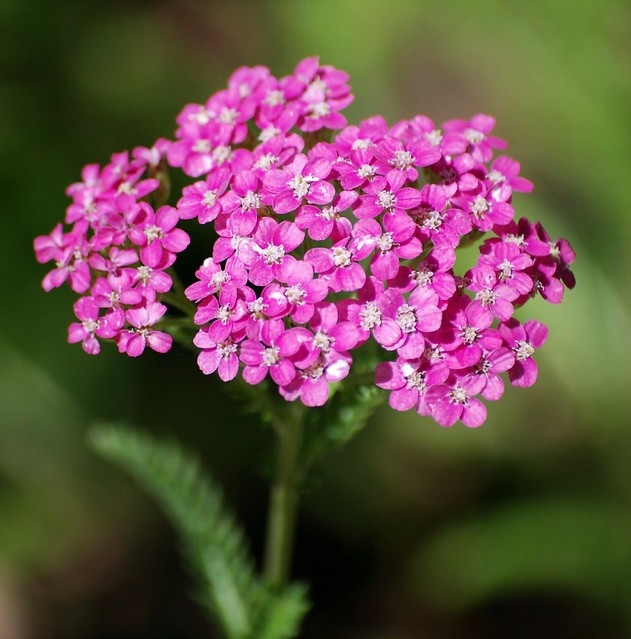
An excellent companion plant to consider for a Hop vertical wall is the Island Pink Yarrow (Arboretum All-Star Achillea millefolium rosea Island Pink). It is a western native drought tolerant perennial spread by rhizome which will grow in a host of soils though inland plants should be afforded some shade. It has bright pink flower sprays atop 12-18” stems.
- Author: Lee Miller, Master Gardener
When should I prune shrubs in the landscape?
Knowing when to prune and how to prune are important aspects of gardening to know; especially to be a relaxed, at-ease gardener. The first rule is to understand that not all shrubs and plants need to be pruned. One principle of gardening is right plant-right place. Don't plant where there is insufficient room for the plant so that annual trimming is necessary to keep the plant in bounds.
I think Rule 1b is to consult a pruning guide and look up the plant to see if pruning is recommended and if so when and how should it be done. Remember that not all plants need to be pruned and if those that don't need pruning are pruned, it may cause more harm than good if their natural form is good to start with. There are also safety reasons to remove plant material that is hazardous to people on walkways, driveways, or paths where people traverse.
The second rule; Plants that bloom early, roughly before May 1, are pruned after they bloom. This group includes Spirea, mock orange, Weigela, Camellias, and Lady Banks Rose as examples. The flower buds for these early bloomers are often set in the summer before the spring bloom (old wood bloom set), so pruning before bloom will eliminate many of the flower buds.
Third Rule: Summer flowering plants that bloom roughly after May 1 and have blooms that occur on new growth are usually pruned in the winter or early spring before bud break (new wood bloom set); e.g., butterfly bush, Caryopteris, crape myrtle, roses, and some hydrangea. This also includes fruit trees such as plums, peaches, pears and apples. It is good to avoid winter or spring pruning of cherries and apricots because they are susceptible to Eutypa, a fungus disease that will gain entrance through pruning wounds and cause die back in the infected limb. These two trees are best pruned after the crop in harvested in the summer.
Fourth Rule: Hydrangeas. Hydrangeas account for lots of pruning questions. That is because some bloom on "old wood" (Rule 2) while others bloom on "new wood"(Rule 3). Hence you need to identify what kind of hydrangea you have and follow the appropriate rule. Hydrangea macrophylla, the ones with big blue or pink flowers, and Hydrangea quercifolia, oakleaf hydrangeas, both bloom on old wood and hence follow Rule 2. The little pruning they need should be done immediately after flowering. Hydrangea paniculata, which have white, conical flowers, and Hydrangea arborescens, such as ‘Annabelle', bloom on new wood. They will produce better flowers if cut back in late winter.
Fifth Rule: Don't be afraid to prune at any time for diseased, dead, broken or crossing branches, or stray branches whose removal could improve the appearance of your shrub. For more information on pruning, go to: https://dyckarboretum.org/pruning-guide/. It is also possible to keep fruit trees at a lower height by summer pruning which decreases vigor. For more information on summer pruning and training of fruit trees see: http://homeorchard.ucdavis.edu/8057pdf
- Author: Melissa Berg, Master Gardener
There are many reasons to cultivate a vertical garden: small spaces, implementing aesthetic visuals, creating noise barriers or living fences, and even blocking a nosey neighbor. The decision to install plants that want to climb is relatively simple. The bigger question is what plant will fulfill the needs of the garden and, in so doing, please the gardener.
If rapid vertical growth is needed and planting is happening well into June, consider obtaining Humulus lupulus (aka Hop plant). There are five varieties of hop grown around the world, three of which are native to North America. Western hop, H. l. var. neomexicanus, enjoys full sun all day and requires moderate waterfall. Both male and female plants are wind pollinated and separately produce flowers, though bees and butterflies enjoy the strobili or cone of the female plant exclusively. It is this strobili or flower which is commonly referred to as “hops.”
Interestingly, hop plants are considered by many to be a vine due to their stiff, downward facing hairs which provide stability and, in turn, allows them to easily climb to heights of 15 to 20 feet in a relatively short period of time. While they will die back to a cold-hardy rhizome during late Autumn, hop is a perennial herbaceous plant that has been known to live upwards of 20 years.
The yellow leafed cultivar Aureus or “golden” hop has been recognized by the Royal Horticultural Society and is widely cultivated for garden use. It is capable of providing a lush cascade of bright golden leaves either as a focal point or simply intertwined with standard green varieties. As the hop will reduce as winter approaches, allowing a climbing vine such as the clematis to share its trellis or lattice will allow the flowering vine to take center stage during colder months.
Keep in mind that the hop is an aggressive growing plant and has the tendency to smother other plants absent consistent pruning; thus, any companion plants should be installed about a foot away. Companion plants should be selected to play a specific role according to their individual characteristics. For example, chives and coriander both seem to keep aphids away from cones and new shoots, while marigolds attract beneficial insects, such as bees, and repel cucumber beetles. Anise has a pungent scent that deters many different pests and, simultaneously, acts as a host for predatory wasps which eat sap sucking aphids. Finally, yarrow increases the vigor of nearby plants, is an excellent fertilizer when composted, and attracts lady beetles and beneficial wasps.
Cultivating hop plants requires some planning. The rhizome does best installed about four inches into aerated, well-drained, rich soil. It must be planted horizontally with any visible buds pointing upward. If planting multiples be careful to space them according to your growing plan, i.e., twining requires closer spacing versus as separately individual plants at two feet apart. After installation, cover with lightly packed soil or high nitrogen mulch. Again, be certain you are planting in full sun.
There is no single form of vertical support that is beloved by the hop. Choices include wooden lattice, a garden arch, vertical wood posts with interior wire framework, available pergola column space, or even an old clothesline. The options available are infinite if one considers the requirement of a well-anchored vertical support and that the vines require something to latch onto.
Finally, to train hop plants, trim them once they attain around a foot of growth. At this point, begin training according to the end goal. If done by hand, gently weave the vines around the chosen support system in a clockwise formation to avoid having the hops just fall off. After two months of growth, trim off all the lower leaves to avoid anything damaging being picked up from the soil. Hop may be trained to grow up and cascade over a pergola or gate, though diligence and attention are required. They are a beautiful, if unexpected, addition to any climbing garden.
- Author: Cheryl Carmichael, Master Gardener
Pubescence: soft down or fine short hairs on the leaves and stems of plants. Many plants have pubescence designed to provide a tiny bit of shade to reduce the temperature of the leaves and stems and protect the leaves from losing too much water from transpiration. This evolutionary miracle has allowed many plants to develop a tolerance for high heat, relentless sunshine, and limited water.
Some plants have the hairs on every surface of the plant, e.g. lamb's ear. Some plants limit the hairs to the underside of leaves and new stem growth, e.g. live oaks. These plants often have a leathery, waxy topside to the leaves with the pubescence on the underside protecting the stoma from releasing too much water. New stem growth gradually loses the tender, hairy protection, replacing it with bark.
The Demonstration Garden at the Ag Center has many examples of plants with both prominent and subtle pubescence. Some are evident from a distance: the ruddy colored hairs on the back of magnolia leaves, while others require close inspection: the interior live oak in the driveway courtyard shows pubescence on the stems of the new branch growth. Pet the lamb's ear, lavender, milkweed and Phlomis for a soothing tactile experience.
This term is also used to describe short hairs or the downy covering in animals, especially insects, and reaching puberty in humans, with pronounced hair growth.
- Author: Robin Fuller, Master Gardener
No doubt you've seen the images. Long, sometimes miles-long, lines of people waiting at food banks and food pantries. As the pandemic continues and unemployment rates continue to rise, (18.3% in San Joaquin County as of April 2020, up from 5.8% in April 2019… the highest unemployment numbers since the Great Depression), the challenges for food banks and panties have increased for the continuing and newly food insecure.
During the shelter in place, many people have taken to vegetable gardening as a way to stretch their food budget dollars, pass their time at home, and seek to create some sustainability. Unfortunately, home gardening for those in apartments or homeless is either a limited option or not an option.
In the San Joaquin County, where land prices are less than those in more congested urban areas, and where the soil and climate are conducive for fruit and vegetable growing, there are three, almost secret, gardens dedicated to providing fresh herbs, produce, and fruit for the homeless and food insecure. These gardens are located on a formerly empty patch of land behind a parking lot, alongside a soup kitchen, and at the Stockton Emergency Food Bank and are attended to or supervised by San Joaquin Master Gardeners
The newest garden is located at Grace and Mercy in Lodi. Eight raised beds, along the side of the house which serves as a soup kitchen, were rebuilt as an Eagle Scout project by Clayton Young, and provide fresh herbs and vegetables year-round. Two herb beds, literally right outside the back door to the kitchen, are planted with oregano, sage, chives, rosemary, lemon verbena, a variety of basil, and thyme. The six remaining beds are planted with zucchini, squash, tomatoes, cucumbers, melon and okra. Produce is used onsite and surplus is added to boxes delivered to homebound seniors. For more information on Grace and Mercy, visit: https://gracenmercylodi.com/.
Tucked behind the administration offices at the Stockton Emergency Food Bank are 20 immaculately-groomed raised beds, and a small sitting area. Seasonal plantings include zucchini, tomatoes, peppers, and cucumbers. There are also a dozen fruit and citrus trees. http://stocktonfoodbank.org/.
The third and largest garden is the St. Joseph's Jerry Roek Memorial Garden located behind a parking lot on California Street in Stockton. The garden consists of 32 raised beds, either 16 or 20 feet long. They are arranged in circles and resemble two wagon wheels. Between these two “wheels” is a gazebo which is used as respite for garden volunteers. Eagle Scout Christopher Roek, grandson of Jerry Roek for whom the garden is named, erected a wonderful sign for the garden as his Eagle Scout project. The year-round garden is currently planted with summer crops including lots of tomatoes (the largesse was from a Master Gardener plant sale that was canceled due to the stay-in-place orders), eggplant, peppers, basil, zucchini, and cucumbers. There are numerous stone fruit trees, and a small grove of citrus trees was added this past spring. The produce from this garden is delivered within hours of harvest to the St. Mary's Dining Room where it is used in preparing over 3178,000 meals (2019) to feed the homeless and disenfranchised members of the Stockton community https://stmarysdiningroom.org/ .
Food insecurity is a growing problem. Other San Joaquin gardens help in other ways. Puentes, www.puentesca.org rents community plots, the Black Urban Farmers Association (covered in this summer blog) grows produce for sale through low-income programs and donates to St. Mary's Dining Room), and the Loel Center Community Garden, http://www.loelcenter.net/facility/loel-community-garden/, rents raised garden boxes.
A core value of the Master Gardener program is to teach and extend information to address home gardening and non-commercial horticulture needs, using science-based research. Ordinarily these gardens are also used as outdoor classrooms and once it is safe to again resume in-person classes, we hope to continue with one of our missions of hands-on education for the general public.


